Sixty-one million adults in the United States have a disability that impacts their daily lives. One out of every five U.S. households includes a child with special needs. Last year, 21 percent of people with a disability were active in the workforce, the highest rate since the U.S. Bureau of Labor Statistics began tracking the statistic. Given these numbers, there’s a strong chance that many of the people you work with know someone with a disability, are caring for someone with a disability, or may even be differently abled and undiagnosed themselves.
But what does it mean as a colleague or manager to be intentionally inclusive of people with disabilities, to empathize with team members who have special needs or who are caregivers to those with special needs, and to raise awareness of the power of differing abilities in the workplace? And how well do we genuinely comprehend and appreciate the experiences of our co-workers?
In honor of October being National Disability Employment Awareness Month, we’re exploring the idea of dismantling the unconscious biases that hinder the full integration of the special needs community in the workplace.
First, by interviewing six individuals who experience living with special needs, serving as caregivers, or leading teams with diverse abilities in the business community. Then, by outlining the constraints that many of our colleagues, clients, or employees face daily and creating an inclusion framework to help leaders proactively navigate the issue in their organizations.
We hope that by shedding light on the barriers that need to be broken and the power of different abilities, we can encourage leaders to build intentionally inclusive teams and pave the way for a universally more empathetic working environment.
Meet The Interviewees
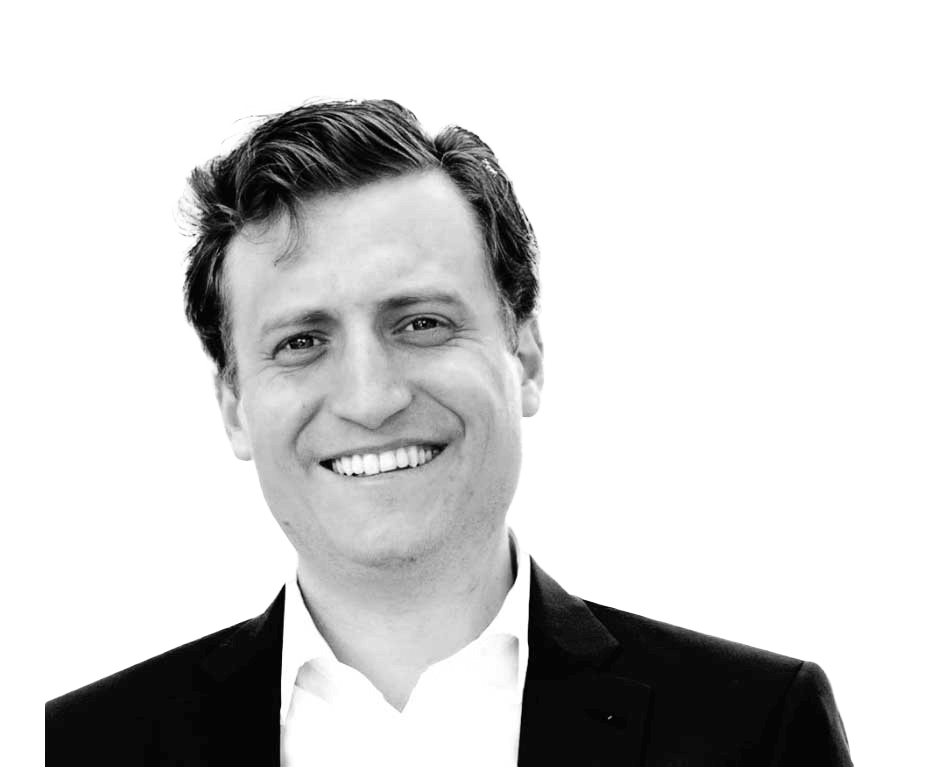
Danny
Gattas
Danny is a senior manager at Jabian Consulting, providing strategic insights and practical solutions to a diverse range of clients. His perspective is informed by his personal experience with learning disabilities, adding a layer of complexity to the challenges he faces in the workplace. He aims to promote awareness and compassion to create more inclusive workspaces for individuals with all types of disabilities.
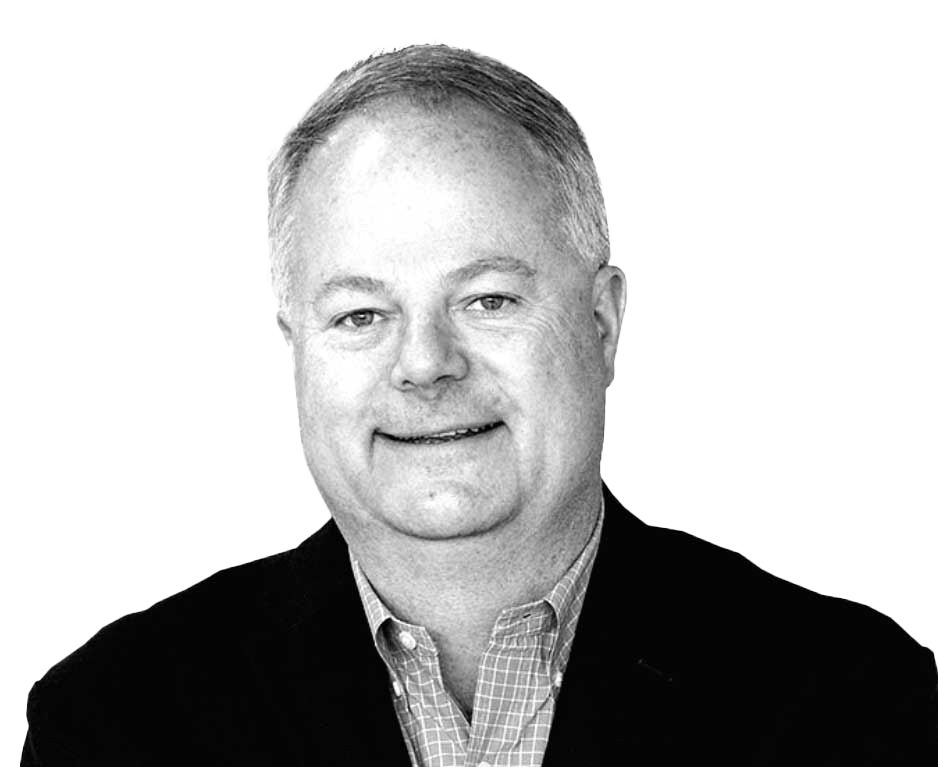
Randy
Hain
Randy is a highly respected executive coach, author, and leadership consultant with more than 30 years of experience in senior management. He is also the father of a son with high-functioning autism and is passionate about promoting autism awareness and advocating for empowering workplace opportunities for adults with special needs.
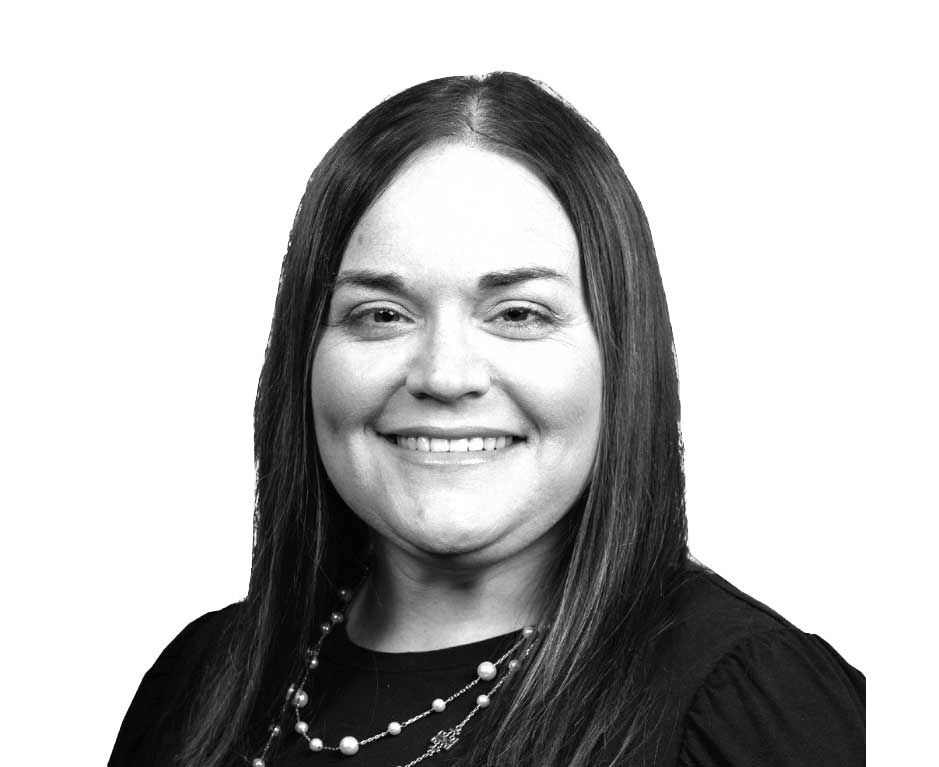
Katie
Hearn
Katie has risen through the ranks of the Atlanta Braves organization and manages a large team as manager of gameday staffing and administration while also serving as the club’s ADA coordinator. She has a passion for “equal access” — not special treatment for people with disabilities — and offers her perspectives as a blind professional.

Manya
Parker
This year, Manya was presented with the Family Member Advocate Award by the Tommy Nobis Center, an Atlanta-based nonprofit that implements innovative programs to meet the employment needs of people with disabilities. Manya graciously shares her journey as a devoted mother to a daughter with autism, shedding light on the tireless efforts involved in caring for someone with special needs. Manya shares workplace insights on supporting co-workers who are caregivers to individuals with special needs.

dAVE
Ward
Dave currently serves as the president and CEO of the Tommy Nobis Center, an organization that empowers people with disabilities (visible and invisible) through employment opportunities while simultaneously offering real business solutions with staff augmentation. Dave shares his leadership perspectives on both managing an organization inclusive of differently-abled people and helping others solve real business problems by doing the same.
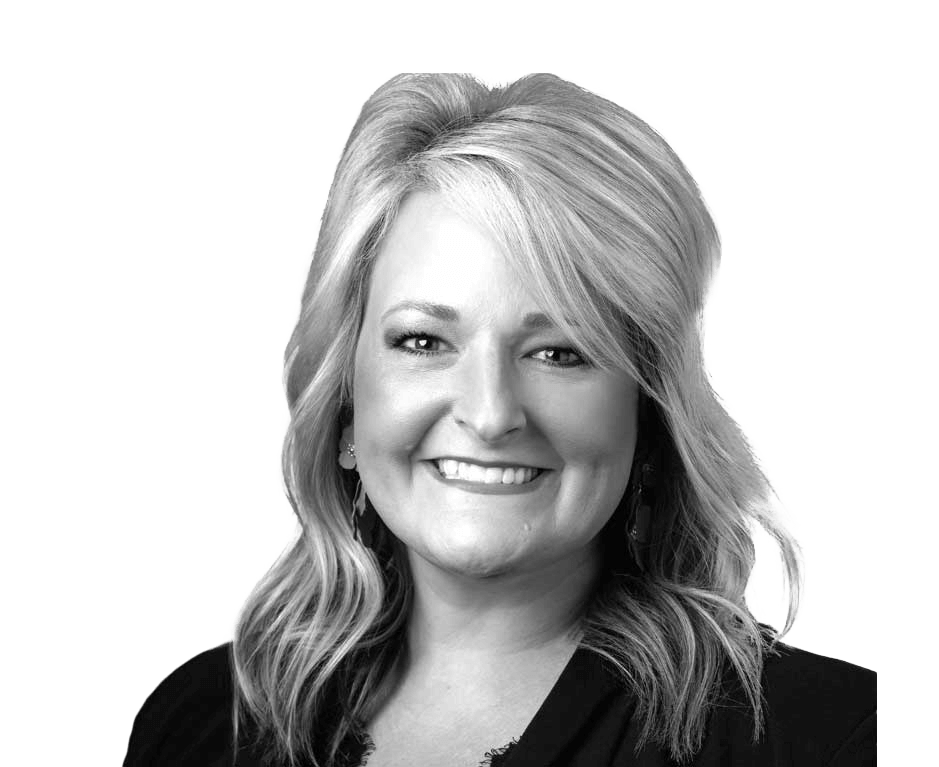
Jennifer
Puckett, LPMT, MT-BC
An accomplished business owner and musician who successfully combined her love of both music and therapy for those with special needs by launching Therabeat Inc., Jennifer is a nationally board-certified music therapist and a licensed Georgia music therapist. She shares her leadership perspectives on advocating for and treating families and children living with disabilities.
Differently
Abled
What does inclusivity in the workplace mean to you?
Katie Hearn: Inclusivity means working with people who are unlike me. Diversity is important and powerful. My team is full of people from all different backgrounds and with different abilities. We each bring our own “superpower” to the table to help the company evolve and grow.
Danny Gattas: Inclusivity in the workplace means showing compassion and empathy to those who are different from yourself and others.
What do you want your colleagues to know about you, someone who is disabled?
Katie Hearn: I’d like them to realize that 25 percent of Americans are living with a disability. And the number is even higher for those supporting someone with a disability. I’d want them to:
Have an Open Mind. Rather than focus on our disabilities, understand that every disability creates and builds other “superpowers” to help compensate. Due to my blindness, I can’t keep up with my schedule by just looking at a calendar. I must allow for extra time due to transportation challenges. As a result, I have become an extreme planner. My “superpower” allows me to remember calendars and schedules for two to three months at a time, in my head. This has turned out to be a huge asset for my team as we constantly juggle event schedules and commitments at the stadium.
Be Curious. When people are curious, it is about “equal access,” not special treatment. Start by thinking about equal access and develop your questions from there.
Don’t Make Assumptions. Give people the independence to thrive. And if you are unsure whether they need something, just ask.
Give People with Disabilities Opportunities. For example, don’t overlook me for opportunities that have nothing to do with my disability. Just because I am blind doesn’t mean I can’t lead important projects or mentor people. You’re not going to hit a home run with every employee you hire, but you should give everyone a chance to surprise you.
Danny Gattas: Experiencing a disability, regardless of its type, can sometimes lead to feelings of shame. Invisible disabilities, in particular, come with their unique set of challenges and opportunities. For instance, I’ve cultivated strong organizational skills and meticulous attention to detail through dedicated effort. Over the years, I’ve honed practices that suit my needs. Just as effective collaboration with individuals hinges on self-awareness and adept communication of one’s strengths and limitations, it’s equally crucial to comprehend both the strengths and weaknesses of our team members. However, you first must be able to manage yourself before you are able to effectively lead others.
How can we encourage others to be intentionally inclusive in the workplace?
Katie Hearn: When you hire someone with a disability, have a clear understanding of their skills, strengths, and needs. Then focus on their positive traits first, share their superpower, and then share their disability as appropriate. It is important to hype the person up from the beginning and celebrate the strengths that they bring to the table. This helps set the bar for how others will engage them.
Danny Gattas: Encouraging intentional inclusivity in the workplace involves creating places that foster diversity, including disabilities. Organizations can foster a more comprehensive approach to diversity, allowing them to thoughtfully address the requirements of individuals with disabilities. By doing so, we create an environment where everyone’s unique needs are acknowledged and catered to.
Organizations should utilize available technology and tools that function to foster inclusive working environments. Understanding how others use technology and the processes they employ to collaborate effectively is crucial. It is important to take time to understand others’ working styles and remain open.
Caregiver
Perspectives
What was your experience learning about the disability of the individual you care for?
Manya Parker: My mother was a special ed teacher, so I had been around special needs children since I was a child. When my daughter was born and wasn’t hitting the expected milestones, I paid attention. She got words, and then she began losing words. And when she was just shy of 18 months, we took her to Babies Can’t Wait (BCW), Georgia’s early intervention program for infants and toddlers with special needs, and a neurologist at Emory University for a full genetic workup.
They found nothing genetically wrong with her and said she didn’t fit the mold for autism. But eventually, they determined she did indeed have it. We had good support through Babies Can’t Wait and our local city schools. In the end, she is our child and our responsibility, but that doesn’t mean I didn’t ask for anything and everything that I thought might help her. I built a support community around her and us, but I never saw her as their responsibility, and I was careful to never abuse those relationships. With that approach, I have found many willing to help and support us.
Randy Hain: I vividly remember the moment my wife Sandra and I heard the diagnosis when our son Alex was just 25 months old. We had a gut feeling something was going on for several months and the doctor’s diagnosis confirmed it. We just looked at each other for a few moments and quickly determined this journey would be a testimony to our marriage and the deep love we felt for our son. We had to figure out a way to help him. We did the research and got the best help we could find. This was back in the early years when the medical community was still determining how to help kids on the spectrum. There weren’t a lot of available resources, but we committed ourselves to doing everything we could because we loved our son. We kept the focus on supporting each other and our marriage, making sure Alex was included in everything we did as a family, and made sure that he was connected to our faith community. Alex’s faith is very important to him. He is a lector in our parish and reads scripture to a thousand people at Mass regularly. He has a part-time job, largely takes care of himself and has found numerous ways to actively engage in life. We are very proud of him.

61M
An estimated 61 million adults in the United States (roughly 1 out of 4) have a disability that impacts major life activities.2
14M
An estimated 14 million children with special needs in the United States.3 That means 1 out of every 5 households in the United States includes a child with special health care needs.
What was your experience learning about the disability of the individual you care for?
Manya Parker: My mother was a special ed teacher, so I had been around special needs children since I was a child. When my daughter was born and wasn’t hitting the expected milestones, I paid attention. She got words, and then she began losing words. And when she was just shy of 18 months, we took her to Babies Can’t Wait (BCW), Georgia’s early intervention program for infants and toddlers with special needs, and a neurologist at Emory University for a full genetic workup.
They found nothing genetically wrong with her and said she didn’t fit the mold for autism. But eventually, they determined she did indeed have it. We had good support through Babies Can’t Wait and our local city schools. In the end, she is our child and our responsibility, but that doesn’t mean I didn’t ask for anything and everything that I thought might help her. I built a support community around her and us, but I never saw her as their responsibility, and I was careful to never abuse those relationships. With that approach, I have found many willing to help and support us.
Randy Hain: I vividly remember the moment my wife Sandra and I heard the diagnosis when our son Alex was just 25 months old. We had a gut feeling something was going on for several months and the doctor’s diagnosis confirmed it. We just looked at each other for a few moments and quickly determined this journey would be a testimony to our marriage and the deep love we felt for our son. We had to figure out a way to help him. We did the research and got the best help we could find. This was back in the early years when the medical community was still determining how to help kids on the spectrum. There weren’t a lot of available resources, but we committed ourselves to doing everything we could because we loved our son. We kept the focus on supporting each other and our marriage, making sure Alex was included in everything we did as a family, and we made sure that he was connected to our faith community. Alex’s faith is very important to him. He is a lector in our parish and reads scripture to a thousand people at Mass regularly. He has a part-time job, largely takes care of himself and has found numerous ways to actively engage in life. We are very proud of him.
What do you want your colleagues to know about you, as someone who is caring for someone with a disability?
Manya Parker: Remember the resource constraints we face. We have often put in several hours before we even make it to the office. So, if we need to hit the restroom and get coffee when we get there, please be patient — it might be the first opportunity we have had to do so! Also, please don’t forget to include us and our special needs children in outside-of-work activities. We can’t always come, but please don’t stop asking. Be inquisitive and ask about our kids. We have a lot of not normal conversations, but we also want to have normal conversations. In terms of which words to use, don’t get caught up in using the latest jargon; just be kind, honest, and polite. Finally, please support our causes with your volunteer time, space, and funds. It really means a lot!
Randy Hain: I want to talk about my wonderful son just like every other dad. Our son is a blessing, and we are proud of him. I also want to support and encourage others who may be traveling the same road. I believe parents of special needs children need to be open and transparent with each other. Families don’t talk about their special needs children enough in public. They often live in silence, fear, and shame. I tell parents to not be afraid of the diagnosis. It doesn’t marginalize the child to discuss their challenges, but instead, an open discussion can open doors to opportunities and resources if more people are aware of your needs. For those of you not living with a child who has disabilities, please be more aware of friends and work colleagues who may be dealing with these issues. If you know or encounter someone like this, be flexible and extend the grace, patience, and love you would want someone to extend to you.
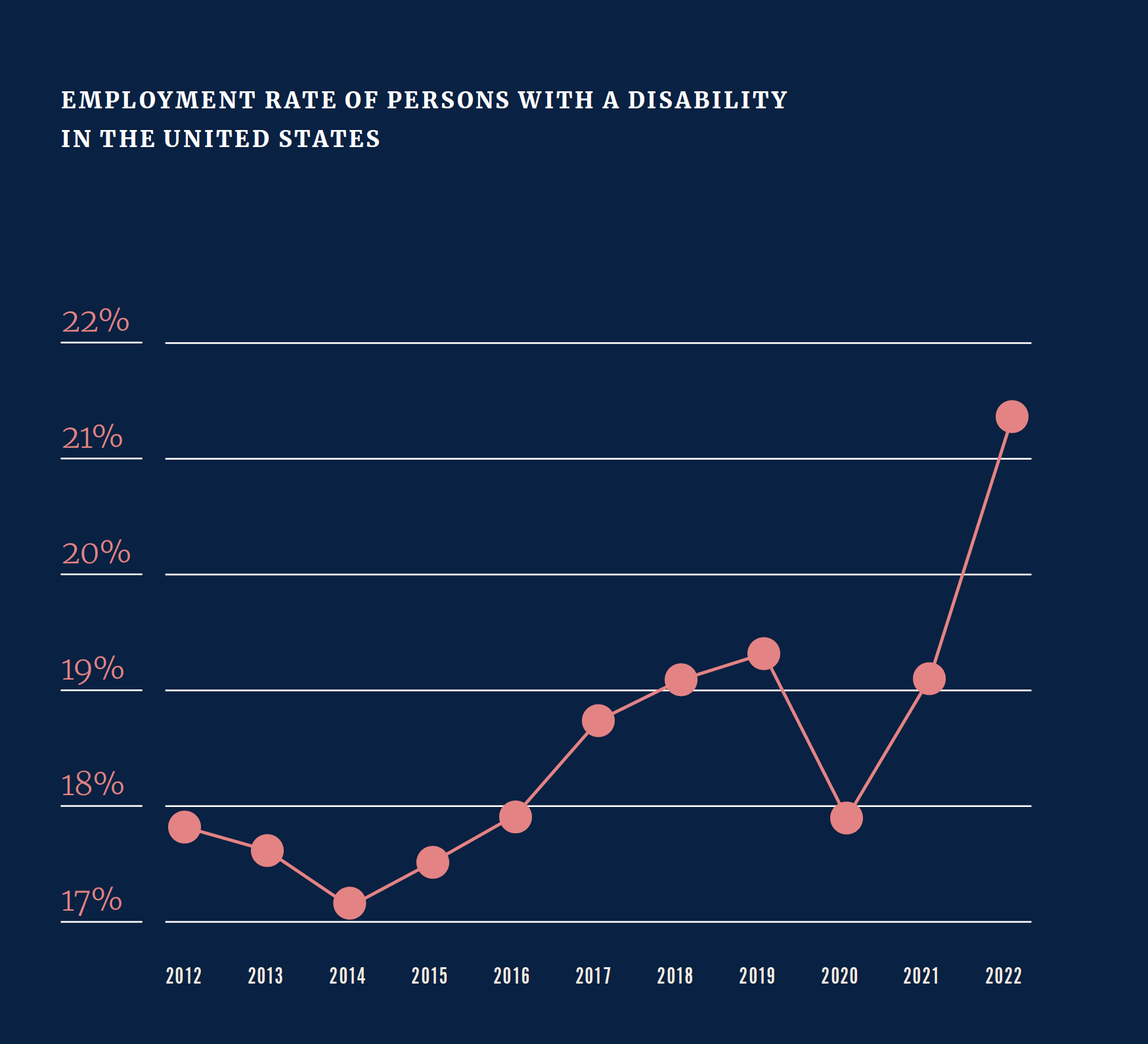
Where do you find support? What are some of the resources that you’ve leveraged?
Manya Parker: There are a lot of great resources out there and even more now, including:
Babies Can’t Wait (Georgia). They were awesome and helped me find a therapist.
FOCUS. A great Georgia-based group that offers get-togethers, camps, and an informative newsletter.
Lekotek of Georgia. A no-cost learning library! It’s a lending library of toys and tools so you know what to buy. But … they also host date nights!
Parent to Parent of Georgia. Mentor program for parents of newly diagnosed children. Parents who are ahead on the “living with disabilities” journey support parents of newly diagnosed children. They point to helpful resources and provide encouragement and emotional support.
Tommy Nobis Center (National). My daughter Darby’s work has given her such self-value and self-esteem! Her co-workers love her and are her closest friends who will help out when needed.
To find similar national resources by state see the CDC listing at https://www.cdc.gov/ncbddd/actearly/parents/state-text.html
Randy Hain: In the old days, it was just Autism Speaks. Since then, the ability of doctors and pediatricians to diagnose early has greatly increased and there are countless resources to help parents and their children on the spectrum. A community of parents who support each other is important and can be incredibly rich on an emotional support level. When Alex got older, we engaged in “Autism Improvised,” a theater program designed to bring autistic people out of their shells. It’s hard for someone on the spectrum to do that and Alex benefited from this experience. He also had a chance to play soccer because a well-known special needs therapist named Clay White founded PEOTSI Soccer here in Georgia. Finally, check out national organizations like The Tommy Nobis Center and The Bobby Dodd Institute that support empowerment through employment.
Leader
Perspectives
What can leaders do to be more inclusive and aware of uniquely abled people in the workplace?
Randy Hain: I encourage everyone to move past assumptions and pre-judgment regarding what these uniquely abled people can and can’t do. Throw the traditional HR job descriptions out the window and get creative. Take the time to find out what adults with special needs in the workforce can offer. It starts with educating ourselves. If companies want to do a better job of bringing in people with special challenges, it has to start with education and a commitment to making your culture a receptive place for people with any form of disability to thrive. It’s not just about reading a book or attending a seminar. It’s about bringing in experts to talk to leaders about the things they might do differently to engage with this often-neglected group in our workforce to help them thrive. Our son works for a global retailer near our home, and they have built a small village of support around him to make it work. He has been there for seven years, and they provide him support, grace, patience, and love every day.
Jennifer Puckett: The first thing is “person-first” language. You would be shocked at how many people don’t realize that “person-first” language is important. Someone will say, “They have an autistic kid” or “Those are the special ed kids” and think they are being sensitive. The labels can immediately shut people down. Consider stepping into their world and asking questions. For example: Does your child have special needs? Can you share with me what you’re dealing with at home? That turn will go from shutting someone down to being receptive and open. Leaders also need to pay particular attention to the examples they are setting. If you come in with insensitive talk, you’re setting the tone for the whole team.

In terms of talent strategy, what should leaders know about the strengths of the disability community and what it has to offer?
Dave Ward: Everyone doesn’t look the same, talk the same, or act the same. If you want true inclusivity, you have to change the hiring process and go after a “well-rounded” candidate pool. Produce healthy discussion and healthy conflict. And if you’re a company that believes in an inclusive workforce, then make it a priority.
Jennifer Puckett: Not everybody is perfect for a job. But it’s important to spend time considering how to better support finding the right jobs for persons with special needs.
What steps can leaders take — and which skill sets should be bolstered in the workforce — to improve inclusivity?
Dave Ward: Extending grace to people who are facing hurdles. For example, when everyone was working from home, the perception that everyone had similar life challenges outside of work changed because we saw people in their environments. Great things can happen when we extend grace.
Randy Hain: Cultivate a mindset of openness. It’s important that leaders “open the aperture of their thinking” about the tremendous capabilities of adults with special needs. Leaders need to be open to new ways of doing things and willing to adapt to include those who don’t fit the traditional mold. Be open to the idea that neurodiverse employees can do a task in a different way and still accomplish the goal or objective. Meet this type of employee where they are…and find ways for them to contribute and add value.
Jennifer Puckett: A learning mindset. Leaders are always learning and need to be learning. As a leader, you must know how to speak to your team about including people with disabilities. Direct and open communication is the basis for a lot of our world issues: The ability and willingness to confront things without bringing conflict. Adaptability to change. What can you do to invest in the lives of your employees? For example, hold face-to-face meetings and foster open communication when circumstances, such as an employee’s schedule, change due to caregiving responsibilities. A willingness to invest in specific industries where it makes sense, e.g., neurodivergent program testers, grocery baggers, cleaners, mailroom, food preparation, etc.
What are the challenges when raising awareness of workplace inclusivity?
Dave Ward: Managing the perception that promoting inclusivity is harder and going to take more resources. We have to provide clarity. You shouldn’t assume it’s harder to hire and support employees with different abilities. That may be the case, but don’t assume it is. Hiring folks with all abilities doesn’t guarantee it will be more time-consuming to support and accommodate. That potential is there with everyone you hire regardless of their abilities.
Randy Hain: I think many well-meaning people are simply afraid. They often make assumptions about people with special needs, e.g., they’ll have emotional outbursts, can’t learn the necessary skills or they are simply unemployable. We need to help people move past these misunderstandings. There are millions of people with disabilities who are gainfully employed,1 my son being one of them! Also, inclusivity is not only about race and gender…we need to promote greater neurodiversity as the next frontier in business if we want to see viable workplace opportunities be offered to often capable people who may simply look and think differently than you and me.
Jennifer Puckett: Platforms for the special needs community are few and far between. When we give presentations at a parent meeting or support group, we are often speaking to the choir. Finding a platform that’s receptive and wants to learn is key. For many organizations, it’s typically the last thing they want to tackle. There is a sense of fear about opening a can of worms that they’re not educated enough to think through. There’s avoidance. We just need to start the conversation.
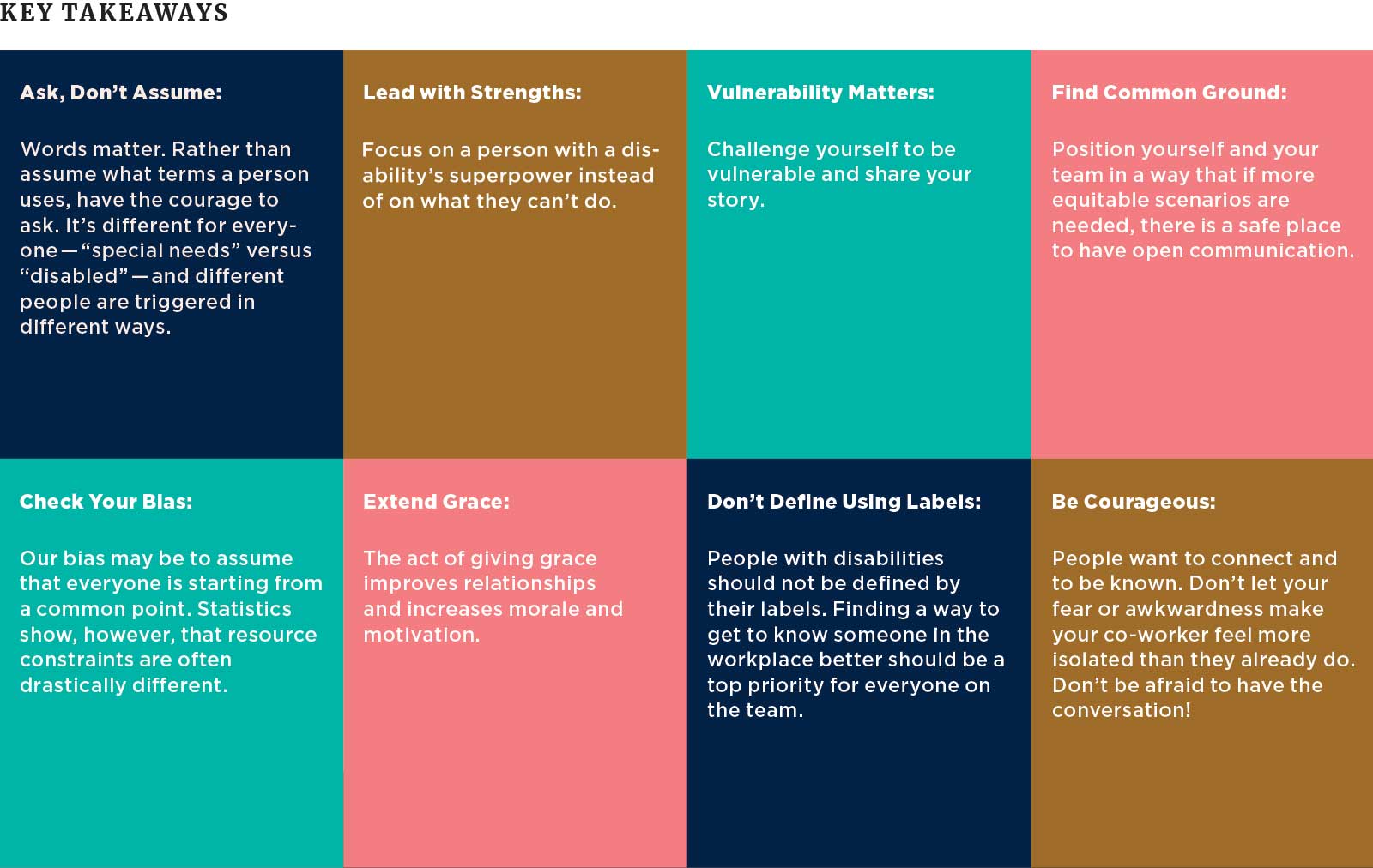
Key Takeaways
Ask, Don’t Assume:
Words matter. Rather than assume what terms a person uses, have the courage to ask. It’s different for everyone — “special needs” versus “disabled” — and differ-ent people are triggered in different ways.
Lead with Strengths:
Focus on a person with a disability’s superpower instead of on what they can’t do.
Vulnerability Matters:
Challenge yourself to be vulnerable and share your story.
Find Common Ground:
Position yourself and your team in a way that if more equitable scenarios are needed, there is a safe place to have open communication.
Check Your Bias:
Our bias may be to assume that everyone is starting from a common point. Statistics show, however, that resource constraints are often drastically different.
Extend Grace:
The act of giving grace improves relationships and increases morale and motivation.
Don’t Define Using Labels:
People with disabilities should not be defined by their labels. Finding a way to get to know someone in the workplace better should be a top priority for everyone on the team.
Be Courageous:
People want to connect and to be known. Don’t let your fear or awkwardness make your co-worker feel more isolated than they already do. Don’t be afraid to have the conversation!
Common Constraints Confronting Employees With (or Caring For) Disabilities
COMMON CONSTRAINTS CONFRONTING EMPLOYEES WITH (OR CARING FOR) DISABILITIES
As consultants, we help our clients solve their greatest challenges. And solving challenges requires making the most of three key resources at our disposal: time, people, and money. Balancing these three to achieve your objectives is paramount to success. As we learned from the statistics and interviews, there are likely individuals within your organization who are living with disabilities or caring for those living with disabilities. These individuals are facing constraints with these same three resources—time, people, and money—but in their own lives. Yet they are persevering. Here’s a quick look at how these constraints might affect someone with, or caring for, a disability.
Time: Many of us struggle with work-life balance. This struggle is exponential for those who have a dis- ability or are caring for someone with a disability. There is an administra- tive burden of countless hours spent on research, doctor appointments, therapies, and filing medical claims and appeals.
Additionally, the variety and geographic dispersion of required therapies and treatments often require individuals to get creative with how they juggle their family and work responsibilities. The National Survey of Children with Special Health Care Needs found that the average family caring for someone with a disability spends 11 hours per week on care coordination.6
People: The impact on people living or caring for an individual with disabilities is varied. The impact on families (marriage and siblings) is staggering. According to a recent survey, the estimated divorce rate is much higher for parents of children with special needs—around 87 percent.7 Mental health can also be impacted. Adults with disabilities experience frequent mental distress almost five times as often as adults without.8 For those caring for others with disabilities, 14.5 percent of caregivers reported experiencing 14 or more mentally unhealthy days in the past month.9
Money: The financial impact on individuals and families dealing with disabilities is twofold. First, lost wages from all families who are forgoing work due to their child’s care needs could total up to $19 billion annually, according to a recent study.10 It is estimated that 25 percent of people caring for children with disabilities curtail their hours or leave the workforce altogether.11
In addition, medical bills pile up as insurance doesn’t cover many ongoing treatments. More than 1 in 4 (26.5 percent) households containing at least one member with a dis- ability had medical debt, compared to 14.4 percent of households with no members with disabilities.12 Furthermore, many providers do not take insurance, so the cycle of losing time due to administrative research and self-filing is constant.
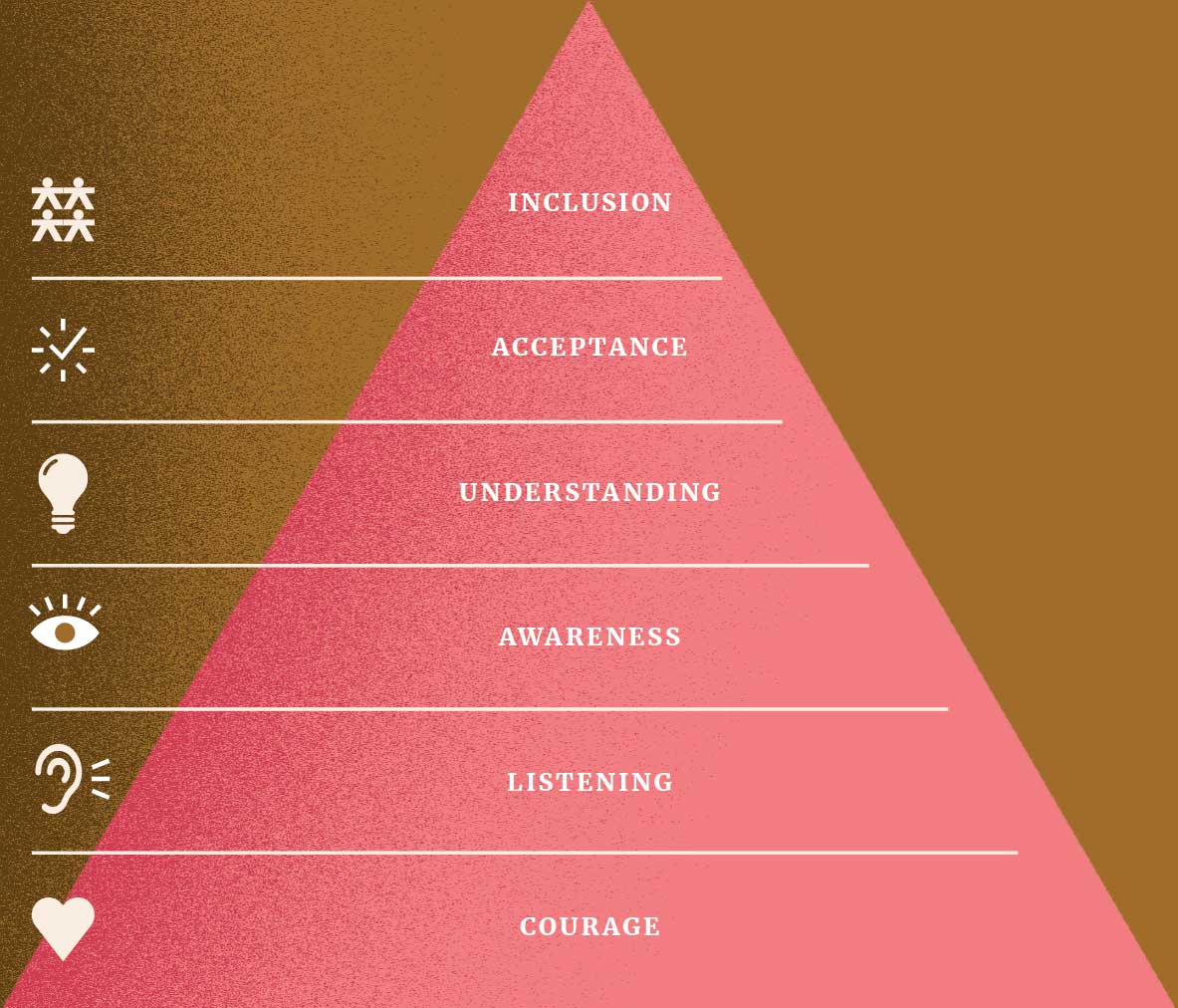
Embracing Company Values Using the Inclusion Framework
One of the advantages of a career in management consulting is the opportunity to experience a variety of corporate cultures with different clients. Across our Jabian clients, we have observed a consistent presence of core values or guiding principles aimed at shaping culture and defining how people interactions occur among employees, customers, and stakeholders. The most common core values are threefold: respect, teamwork, and integrity.
Respect: Valuing your peers and treating each other with courtesy and dignity.
Teamwork: Fostering a supportive and collaborative environment.
Integrity: Doing the right thing no matter what and acting with high moral and ethical standards.
And while writing core values down is one thing, only when these values are embodied and practiced by every member of the team do they make a profound impact on the organization.
Bringing culture to life is not easy, though. It requires consistent messaging, education, and actions to instill the message and intent behind it. So, while we speak of respect, teamwork, and integrity, putting it into practice doesn’t just happen.
It’s easy for people who don’t deal with these challenges to look away, even when they know the statistics. And while the word “inclusive” has gained a lot of traction in workplace discussions in recent years, we must acknowledge the significant gap that still exists when it comes to discussing the issue, and taking action to create an inclusive environment for people with disabilities.
Inclusivity is the practice or policy of providing equal access to opportunities and resources for people who might otherwise be excluded or marginalized. In practice, it means engaging with others free of bias, stereotypes, and discrimination. But how do we get there?
As illustrated in the graphic on the previous page, to be inclusive, we first must be accepting. To accept, we must understand. In order to understand, we must be aware. To be aware, we must listen. And in order to listen, there must be courage. Courage by those who live with disabilities to share their perspectives. And courage by those who do not experience life with special needs to engage in constructive conversation with those who do.
Work cultures that embrace core values such as respect, teamwork, and integrity lay the groundwork for courageous conversations and trust, which in turn builds relationships. And it’s those relationships — and the connectedness and empathy they generate — that drive us to be more intentionally inclusive. As Dave Ward noted in the panel, “There has never been a better time to hire people of all abilities. With the ‘great resignation,’ return to work, and labor shortage, we need to harness the power of our entire culture.”
AUTHOR BIOS
Victoria Inman is a Jabian consultant and the proud mother of a remarkable daughter on the autism spectrum. Initially choosing to keep their autism journey private, Victoria and her husband faced challenges navigating the diagnosis and finding the right care team, while also encountering societal judgment during their daughter’s moments of sensory overload and public tantrums. This experience led Victoria to recognize the power of community and the importance of fostering awareness and understanding. Combining her consulting skills with her passion for photography, she embarked on a mission to capture the essence of those who are differently abled — as well as promote genuine dialogue and societal acceptance — in her captivating coffee table book, “Spark Acceptance.”
Victoria Inman
[email protected]
Inspired by family members who have children with autism, Karen Dernavich is a Jabian consultant and compassionate advocate for families with disabilities. After learning about the transformative power of music therapy in enhancing mood, confidence, motor skills, speech articulation, and cognitive abilities, Karen founded the Duet Project, a Georgia-based non-profit that provides music therapy scholarships to children and adults with disabilities. Through her tireless efforts, she seeks to educate and engage neurotypical individuals and families in a harmonious “duet,” creating a positive impact on the lives of those facing challenges and spreading awareness about their lives.
Karen Dernavich
[email protected]
Sources:
- Statista: In the United States, the employment rate of persons with a disability was 21.3 percent in 2022
- CDC: 1 in 4 U.S. adults live with a disability | CDC Online Newsroom | CDC
- U.S. Census Bureau
- Disability Index siting World Health Organization
- BCG Your Workforce Includes People with Disabilities. Does Your People Strategy?
- National Survey of Children with Special Health Care Needs Data query from the Child and Adolescent Health Measurement Initiative. Available at: www.childhealthdata.org. Accessed January 31, 2016
- Psychology Today
- The Mental Health of People with Disabilities | CDC
- Caregiving for Family and Friends — A Public Health Issue (cdc.gov)
- Disability Scoop
- National Survey of Children with Special Health Care Needs Data query from the Child and Adolescent Health Measurement Initiative. Available at: www.childhealthdata.org. Accessed January 31, 2016
- Who Had Medical Debt in the United States? (census.gov)
